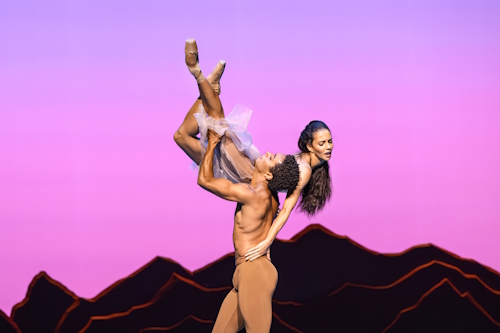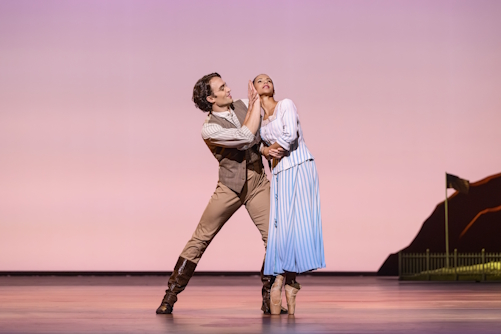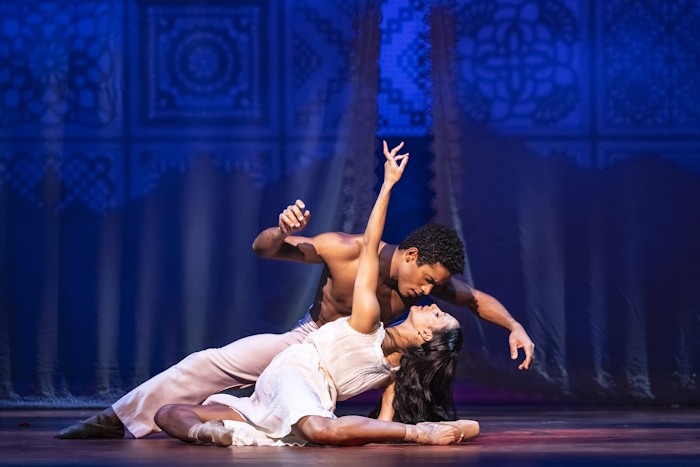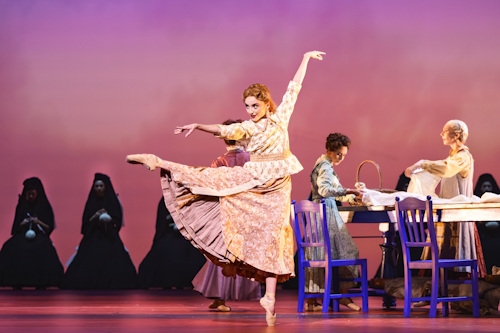Royal Ballet & Opera, London
October 1, 2025
The Royal Ballet opened its new season with a revival of Christopher Wheeldon’s Like Water for Chocolate. On opening night, a second performance of sorts unfolds in the auditorium where Wheeldon and his husband were seated. Wheeldon leans forward, nods with the music, and reacts with such vividness that he almost becomes another spectacle, his presence adding a unique extra to the evening’s drama.
On stage, the production brings together Wheeldon’s long-standing collaborators: composer Joby Talbot, designer Bob Crowley, and lighting designer Natasha Katz. Their collective craft is evident, with stage pictures framed like moving canvases, music shifting between weighty and luminous, and lighting that flows with a cinematic quality. It is everything one expects from a Royal Ballet season opener: grand, sumptuous, and unmistakably entertaining.

in Christopher Wheeldon’s Like Water for Chocolate
Photo RBO / Foteini Christofilopoulou
The dancers give the evening its soul. Francesca Hayward (Tita) burned with intensity from her very first step. Her body did not merely transmit emotion but seemed driven and pushed forward by it. In scenes of conflict with her mother, her movement was torn with abrupt speed and broken force, as if grief and despair ripped her apart. In the pas de deux, she transformed into flowing lines and extended breath, soft yet perilous, stretching emotion into dangerous tenderness. Hayward danced at the edge of vulnerability and eruption, making her performance the dramatic core of the entire work.
Marcelino Sambé (Pedro) appeared restrained in the first acts, his desire pressed down beneath the surface, embodying a man subdued by authority. But in the final pas de deux, his and Hayward’s bodies entwined like serpents, their breath and weight locked in urgent tension. The stage seemed to thicken into heat and humidity, as if the Mexican sun had been brought indoors. In this physical fusion, Sambé at last stood on equal ground with his partner.
Fumi Kaneko (Mama Elena) offered a portrayal filled with contradiction. Outwardly her authority sometimes lacked weight, but in the recollection scene, where Elena’s own trauma surfaces after the murder of her lover and her forced marriage, Kaneko revealed a woman scarred and enraged. Her striking gesture of beating the floor during a quarrel with Tita was less villainy than exhausted despair. This crack in her façade allowed Mama Elena to be read not simply as a cruel mother, but as a broken woman whose severity grew from pain.
Wheeldon’s command of physical language is most startling in the scenes of desire. He magnifies the language of feet, sculpts bodies into entwined forms, and pushes lifts into disquieting extremes that confront the viewer with both beauty and unease. One of the most compelling sequences involves Gertrudis, danced by Viola Pantuso. Consumed by passion, she abandons all restraint, her body sculpted into shifting statues through multiple lifts; a tableau of shameless surrender to desire.
The contrast with the clean, militaristic formations of the revolutionary soldiers later on was striking. The entrance of Mama Elena’s ghost shifts the entire atmosphere, Kaneko’s heightened physicality combining with design and lighting to summon an apparition both terrifying and absurdly carnival-like, recalling giant figures from Día de los Muertos processions. The black-clad woman knitting and the ghostly bride add to a sense of ever-present witnesses, shadows cast over every action.
In contrast, Wheeldon’s more delicate side appears in the lovers’ gesture of rubbing heads together, like two kittens, tender and playful, yet still wrestling for dominance. Such details were quietly poetic.

in Christopher Wheeldon’s Like Water for Chocolate
Photo RBO / Foteini Christofilopoulou
Yet the ballet’s central weakness lies in what it chooses to emphasise. Laura Esquivel’s novel is fundamentally a story of women and the struggle of female power within family and tradition: mothers and daughters, sisters and daughters, mothers and their own mothers. Wheeldon does not erase this entirely, he stages mothers clutching daughters by the neck, arms circling their throats, the physical struggle between Tita and Elena after the baby’s death, the jealousy between sisters, but he relegates these conflicts to the margins. They remain fragments rather than the true spine of the ballet.
Most telling is the recurring motif of the ‘doll lift.’ Whether with Pedro or Dr Brown, Tita is repeatedly raised upright from the waist, suspended like a figurine. It is beautiful, even romantic to watch, but it underscores her passivity, Tita is always the one lifted, never the one in control. The language of love and passion here disguises a structure of possession.
The symbols of food, fire, tears, and ghosts, all potent in Esquivel’s text as markers of female experience, become in Wheeldon’s hands primarily scenic devices, enriching the exoticism but losing their bite. The ballet, therefore, ultimately delivers not a story of women but a spectacle of love and desire: dazzling, atmospheric, but thin in depth.
As entertainment, Like Water for Chocolate succeeds. Audiences receive a rich, magical, exotic tragedy. But in terms of substance, it remains at the surface. When a female narrative is translated into symbols of passion and romance, one question lingers: what, in that process, have we lost? What we have lost, perhaps, is precisely the voice of women. That was the force which once made this story burn from within.


